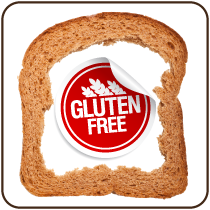
Never mind Zombies or Goblins, the scariest thing in town this October is poor misunderstood Gluten. A few years ago everything was carb free. Now the media talks about gluten like it’s the Ax Murderer of Food Things.
Tummy hurts? Must be gluten allergies.
Have headaches? Oh, it’s definitely gluten intolerance.
Stub your toe? That’s what you get for reaching for that gluten-filled piece of toast.
Gluten has been extraordinarily criminalized in the past year, but is it justified? Many of us are shopping gluten-free…but do we really know what we are doing?
What is Gluten Anyway?
Gluten refers to plant proteins, especially found in the endosperms of wheat seeds. Its part of the nutrient system for many grains and it affects the chewiness of these grains when used as dough in baked goods. That pizza dough you love so much? That delicious texture is all due to gluten.
Primarily gluten consists of two different proteins – glutenin and gliadin. “True gluten” is considered to be a wheat specific protein, but it is also found in other cereals like barley, rye and other crossbreed seeds. Beyond the bakery, gluten is used in various products such as fast food, pet food, imitation meat, and also across various dermatological preparations, hair products, and cosmetics.
Basically, gluten is everywhere.
And it has been everywhere for a really long time. Gluten has been a food substitute for ages. But as incidents of certain health conditions increase, medical experts are questioning the wisdom of high-gluten diets. The main health concerns involve Celiac Disease and Non-Celiac Gluten Intolerance.
Gluten As A Health Villain
Celiac disease isn’t pretty. It’s painful and in chronic cases it can be life threatening. It is characterized by unpleasant digestive symptoms such as stomach cramps and diarrhea. Worse than the gut-gripping pain, is the internal damage that takes place. When people with celiac disease ingest gluten, their immune system responds attacking and damaging the lining of the small intestine.
And guess what? Your intestines are the main point of nutrient absorption for the human body. Over time, celiac disease leaves the body unable to absorb nutrients into the bloodstream, which can lead to malnourishment.
There also people who are known to be gluten-intolerant. These individuals display very similar symptoms to celiac disease, but the lining of the intestine isn’t harmed. While studies are not conclusive, it is possible that in some people, gluten can also trigger migraines, muscle and joint pain, and aggravate conditions such as fibromyalgia and chronic fatigue syndrome.
To avoid these symptoms, many people have opted for gluten-free diets. Happy to oblige (and charge handsomely), the food industry has gone into hyper-drive with gluten free products. Baked goods, pasta, rice, and even beer, yes BEER, is available-gluten free.
So, Is It Just Hype or Gluten-phobia?
No, it’s not just hype. Celiac disease and many forms of gluten intolerance are very real and can cause significant pain and discomfort. The availability of gluten-free foods is a literally a life saver for many people.
On the other hand, food products that have a “gluten-free” label are big business these days. While you are surfing through television channels, you will frequently see celebrities speaking about their new gluten-free diet and the benefits. People who have never experienced the slightest tummy flutter after eating a pound of bread, are suddenly denouncing gluten and joining the gluten-free “movement”.
Despite the negative press, gluten isn’t an inherent toxin. In fact, many of the grains that contain gluten are a good source of fiber, vitamins, and minerals. The gluten-free substitutes are often composed of refined grains that are lower in nutrients. Unless you have a proven history of gluten related health issues, you are likely better off eating whole grains – gluten and all.
To Gluten or Not to Gluten
Given the research available today, there isn’t a reason to avoid gluten unless you have specific adverse reactions to it. More important is to consuming balanced meals that deliver nutrients to your body from a varied and diverse source of food groups. You know the old saying “Everything in Moderation”.
If you choose to follow a gluten-free diet, try foods that are minimally processed. High fiber gluten food could be replaced by wild and brown rice, buckwheat, gluten-free oat, quinoa, and millet. To maintain a balanced diet, it is also advisable to include a lot of vegetables and fruit in your meals. This ensures you are keeping essential fibers, mineral, and vitamins in your diet.
If you are trying to eat healthier, but just can’t decide if gluten-free is right for you, call i spa Health Studio at 727.386.4004 to schedule a free consultation with our in-house Weight Loss Coach. There are many options for improving health through diet and we can help you find the right plan to achieve your wellness goals.




